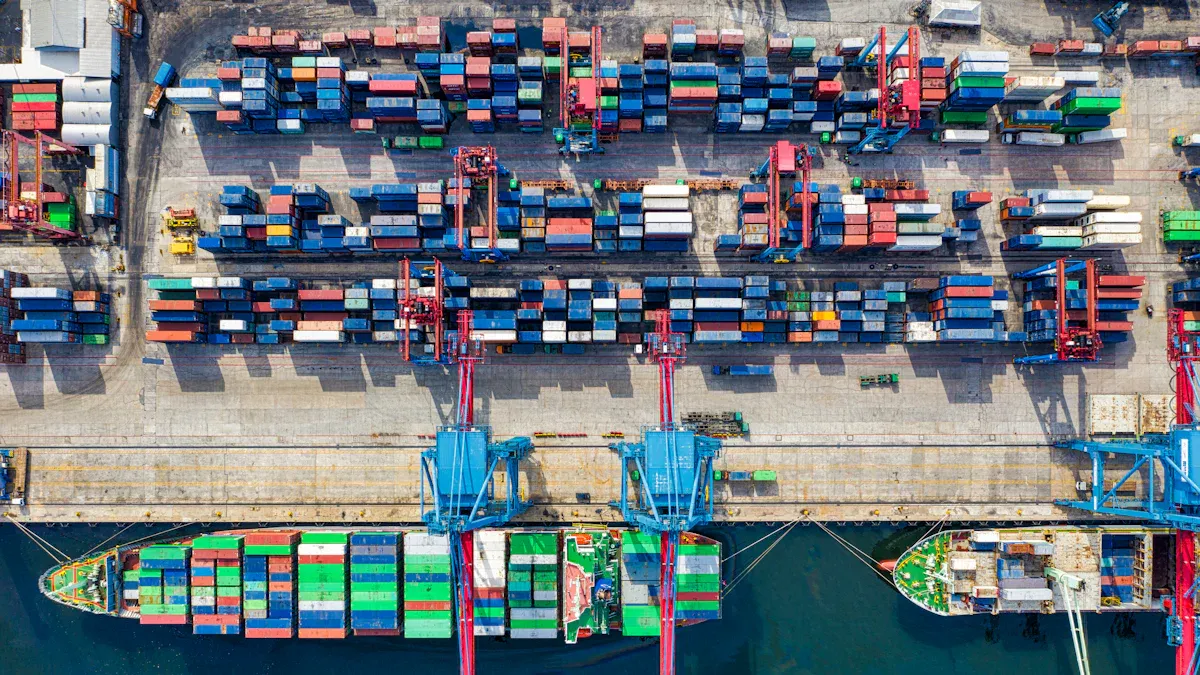Key Differences Between Logistics and Supply Chain Management in 2025

You often hear about logistics and supply chain management, but do you know how they differ? These two fields shape how businesses operate today and will evolve by 2025. For example, automation speeds up logistics processes, while cloud-based solutions improve supply chain adaptability. Companies now open regional warehouses to meet growing delivery demands. The logistics supply chain is transforming rapidly, and understanding these changes helps you stay ahead.
Key Takeaways
Logistics handles moving and storing goods, while supply chain management plans the whole process from start to finish.
Knowing how logistics and supply chain management differ helps businesses work better and keep customers happy.
New ideas like using robots and being eco-friendly are changing logistics and supply chain management, so companies must adjust to stay ahead.
Defining Logistics and Supply Chain Management
What Is Logistics? A Tactical Approach
Logistics focuses on the movement, storage, and handling of goods within a company. It ensures that materials and products flow efficiently from one point to another. You can think of logistics as the backbone of daily operations. It handles tasks like transportation, warehousing, and inventory management. For example, 66% of logistics companies have adopted digital transformation strategies to improve efficiency, while 34% are planning to do so. This shift highlights the tactical role logistics plays in streamlining operations.
Statistic | Description |
|---|---|
34% | Percentage of shipping and logistics firms without a digital transformation strategy but considering one. |
66% | Percentage of logistics companies that have a digital transformation strategy in place. |
38% | Percentage of enterprises optimizing supply chain technology with a focus on end-to-end processes. |
What Is Supply Chain Management? A Strategic Perspective
Supply chain management takes a broader view. It oversees the entire process of sourcing, production, and distribution. Unlike logistics, which focuses on specific tasks, supply chain management connects multiple departments like purchasing and sourcing. This strategic approach ensures that every part of the supply chain works together seamlessly. For instance, 85% of companies plan to use technology for inventory optimization, showing how supply chain management prioritizes long-term goals.
Statistic | Description |
|---|---|
16 | 66% of companies are exploring nearshoring, indicating a strategic shift in supply chain sourcing closer to home. |
18 | 85% of companies plan to use technology for inventory optimization, showing a focus on technological integration in supply chain management. |
19 | 78% of companies are increasing safety stock as a risk mitigation strategy, reflecting a proactive approach in supply chain management. |
How Logistics and Supply Chain Management Interact in Practice
Logistics and supply chain management work hand in hand. While logistics focuses on moving and storing goods, supply chain management ensures that these activities align with broader business goals. For example, logistics handles transportation and warehousing, while supply chain management oversees procurement and production. Together, they create a seamless flow of goods and information. This collaboration improves customer satisfaction and gives businesses a competitive edge.
Key Differences Between Logistics and Supply Chain Management

Scope: Logistics as a Subset of the Supply Chain
You can think of logistics as a smaller part of the larger supply chain. Logistics focuses on moving and storing goods, while supply chain management covers everything from sourcing raw materials to delivering finished products. For example, logistics ensures goods are transported efficiently, but supply chain management connects this process with procurement and production.
Aspect | Logistics Management | Supply Chain Management |
|---|---|---|
Focus | Broader range including procurement, production, and distribution |
This relationship is similar to how the circulatory system works in a body. Logistics moves goods like blood flows through veins, while supply chain management ensures the entire body functions smoothly.
Strategic vs. Operational Focus in Supply Chain Management
Logistics handles operational tasks like transportation and warehousing. Supply chain management takes a strategic approach, focusing on long-term goals such as supplier relationships and market trends. For instance, logistics might optimize delivery routes, while supply chain management decides where to open new warehouses to meet future demand.
Aspect | Supply Chain Management (SCM) | Logistics |
|---|---|---|
Strategic Level | Purely operational decisions around transportation |
Timescales: Short-Term Logistics vs. Long-Term Supply Chain Planning
Logistics operates on short to medium-term timelines. It focuses on immediate needs like inventory levels and delivery schedules. Supply chain management, on the other hand, plans for the long term. It considers factors like market growth and supplier performance to ensure sustainability.
Aspect | Timescale |
|---|---|
Logistics | |
Supply Chain Management | Long-term strategic planning |
Value Creation: Efficiency in Logistics vs. End-to-End Optimization in Supply Chain
Logistics creates value by improving efficiency in transportation and storage. Supply chain management goes further by optimizing the entire process, from sourcing to delivery. This end-to-end approach reduces costs and enhances customer satisfaction.
Data Usage: Tactical Insights vs. Strategic Decision-Making
Logistics relies on data like lead times and inventory levels to make tactical decisions. Supply chain management uses broader data, such as market trends and supplier performance, for strategic planning.
Aspect | Logistics | Supply Chain Management |
|---|---|---|
Data Focus | Lead times, inventory levels | Market trends, supplier performance |
Stakeholder Management: Internal Logistics vs. External Supply Chain Collaboration
Logistics primarily involves internal teams managing transportation and storage. Supply chain management requires collaboration with external stakeholders, including suppliers and distributors. This broader focus ensures the entire supply chain operates efficiently.
Real-World Example: JUSDA’s Warehouse Solutions in Logistics and Supply Chain
JUSDA’s warehouse solutions highlight the interaction between logistics and supply chain management. Its advanced systems, like Juslink, provide real-time inventory tracking, which supports logistics operations. At the same time, these solutions integrate with supply chain management strategies to optimize procurement and distribution. By combining logistics efficiency with supply chain innovation, JUSDA helps businesses achieve seamless operations.
Addressing Misconceptions About Logistics and Supply Chain
Why Logistics and Supply Chain Management Are Often Confused
You might wonder why logistics and supply chain management are frequently mistaken for one another. This confusion often arises because both focus on the movement of goods and information. They share goals like improving customer satisfaction and operational efficiency. For example:
Both aim to deliver products on time.
Both strive to reduce costs and optimize operations.
Both involve managing the flow of materials and services.
This overlap can blur the lines between their roles. Additionally, a misunderstanding of supply chain operations contributes to these misconceptions. Many people fail to recognize how supply chain management connects broader business strategies, leading to ineffective policies that don’t address real challenges.
Overlapping Responsibilities and Terminology
The responsibilities of logistics and supply chain management often overlap, further fueling confusion. Logistics focuses on tasks like transportation and warehousing, while supply chain management ensures these activities align with strategic goals. However, both disciplines require coordination of supplies, labor, and facilities.
Aspect | Logistics | Supply Chain Management |
|---|---|---|
Focus on Material Flow | Oversees movement of materials | Ensures efficient flow from origin to consumption |
Customer-Centric | Aims to meet customer demands | Enhances satisfaction by timely delivery |
Efficiency | Strives to optimize operations | Reduces costs and improves efficiency |
Coordination | Involves coordinating processes | Ensures smooth flow of goods |
Information Flow | Manages tracking and monitoring | Vital for planning and decision-making |
Quality Control | Maintains product quality | Ensures proper condition during transport and storage |
This table highlights how their functions intersect, making it easy to see why people confuse the two.
Practical Tips to Differentiate Between Logistics and Supply Chain Management
To avoid confusion, you can focus on their distinct roles. Logistics handles the tactical side, like moving and storing goods. Supply chain management takes a strategic approach, overseeing the entire process from sourcing to delivery. Here are some tips to help you differentiate:
Think of logistics as a subset of the supply chain.
Remember that logistics focuses on short-term operations, while supply chain management plans for the long term.
Consider how supply chain management integrates multiple departments, while logistics focuses on specific tasks.
By understanding these differences, you can better appreciate how each contributes to business success.
The Future of Logistics and Supply Chain Management in 2025

Emerging Trends in Logistics Supply Chain: Automation and Sustainability
Automation and sustainability are reshaping the logistics supply chain. Automation technologies, such as AI-powered inventory systems and drone deliveries, are becoming more common. These tools reduce human error, improve response times, and address staffing shortages. For example, robotic arms now handle repetitive tasks in warehouses, while barcodes and IoT sensors ensure accurate tracking.
Sustainability is another key trend. Companies aim to achieve end-to-end visibility, which enhances transparency and responsiveness. This focus on visibility aligns with goals like efficiency and resiliency. Sustainable practices, such as using electric vehicles for transportation and optimizing delivery routes, reduce environmental impact. These changes not only meet consumer expectations but also improve operational efficiency.
Supply Chain Management Priorities: Resilience and Digital Transformation
Resilience and digital transformation are top priorities for supply chain management in 2025. Businesses are adopting risk management strategies, such as multi-sourcing and contingency planning, to handle disruptions. These approaches ensure that supply chains remain stable during unexpected events.
Digital transformation plays a crucial role in enhancing efficiency. Technologies like AI and IoT enable real-time decision-making and improve operational processes. For instance, IoT devices provide real-time updates on transportation routes, helping you avoid delays. Sustainability initiatives also align with consumer demand for responsible practices, making them a strategic focus for businesses.
JUSDA’s Role in Shaping the Future of Supply Chain Management
JUSDA is at the forefront of innovation in the logistics supply chain. Its JusLink platform integrates AI and IoT to provide real-time visibility and collaboration. This technology helps businesses optimize transportation and inventory management. JUSDA also emphasizes sustainability by offering solutions like electric vehicle fleets and energy-efficient warehouses.
By combining automation, digital transformation, and sustainable practices, JUSDA helps you adapt to the evolving supply chain landscape. Its global network and advanced tools ensure seamless operations, making it a trusted partner for businesses worldwide.

JUSDA Solutions
To provide you with professional solutions and quotations.
Logistics and supply chain management work together to drive business success. Logistics ensures the efficient movement of goods, while supply chain management oversees the entire process from sourcing to delivery. Together, they create seamless operations that enhance customer satisfaction and reduce costs.
Aspect | Logistics | Supply Chain Management |
|---|---|---|
Focus | Movement of goods and materials | Overseeing the entire supply chain process |
Goals | Efficient flow, cost minimization, customer satisfaction | Efficiency, cost reduction, customer satisfaction |
Coordination | Manages transportation, warehousing, inventory | Coordinates suppliers, manufacturers, distributors |
Information Flow | Ensures timely delivery and condition of products | Tracks shipments and monitors inventory |
Quality Control | Maintains product quality during transport | Ensures quality throughout the supply chain |
Order Fulfillment | Coordinates physical movement of goods | Optimizes supply chain for timely production |
Inventory Management | Focuses on warehousing and order fulfillment | Handles demand forecasting and supplier relationships |
Distribution Networks | Manages day-to-day transportation and warehousing | Designs strategic distribution plans |
JUSDA exemplifies this integration with its advanced warehouse services, which combine logistics efficiency with supply chain innovation. By leveraging technologies like JusLink, JUSDA helps businesses optimize operations and adapt to future challenges. In 2025, you must embrace advanced tools and resilient strategies to stay competitive in a rapidly evolving market.
See Also
Transforming Logistics Through Innovative Supply Chain Strategies
Top 5 Trends Shaping Future Supply Chain Efficiency
How AI Is Transforming Logistics for the Future
